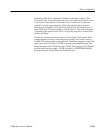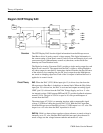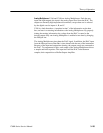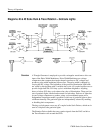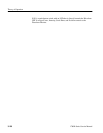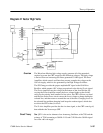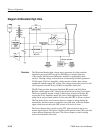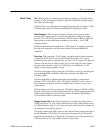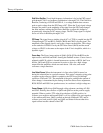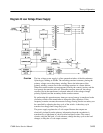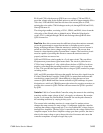
Theory of Operation
3–108
1780R-Series Service Manual
C130 provides a low impedance current path for the base drive winding of T240.
R222 limits Q221 base current.
Power Supplies. CR151 is a potted assembly of diodes and capacitors which
provides a DC output equal to four times the peak input voltage. The output
provides +11K volts DC post acceleration to the CRT anode.
CR150 rectifies the minus peaks from the transformer secondary to provide the
–2.75K volts CRT cathode potential.
CR451 rectifies the positive peaks from a T240 (pin 6 & 7) winding to provide
the +100 V that powers the Z-Axis Amplifiers.
Error Amp. U210 senses the +100 volts and the current in the high voltage
winding through R250 and C110. This feedback sensing holds the high voltage
constant over varying intensity levels, at the expense of +100 volts regulation.
The Error Amp output controls the current through R111 and R120 to adjust base
current for the High Volts Oscillator, Q221.
The Error Amp is stabilized through several frequency compensation elements:
C111, C321, and R112. If one or more of these elements is defective, the Error
Amplifier may oscillate, or have a poor response time.
Q220 provides a slow start on power-up. C320 pulls the base of Q220 low. When
the base of Q220 goes low, the emitter pulls down on CR120 to prevent the Error
Amp from providing base current to the oscillator. Eventually, R121 charges
C320 and the oscillator is allowed to start.
Grid Drive Rectifier. Z-axis high frequency information is fed to the CRT control
grid through C263. Low frequency information is through C264. The Grid Drive
Rectifier, consisting of CR170 and CR171, is a voltage doubler that converts
peak-to-peak voltage from the PP Clamp to DC. When the Z-axis signal voltage
changes, the peak-to-peak amplitude of the signal from the PP Clamp changes
the same amount, causing the Grid Drive Rectifier to reflect this change by
proportionally changing its DC output voltage. The PP Clamp signal is coupled
across a 2.75 kV boundary through C264.
PP Clamp. The signal from a winding (pins 6 & 7) of T240 is coupled into the PP
Clamp through C460 and R370. Diodes CR370 and CR371 clip the signal. The
amplitude of the clipped signal is set by the voltages on the diodes. The voltage
on the cathode of CR371 is set by the CRT bias control (R373) and the anode
voltage on CR370 is the same as the output of the Z-Axis Amplifier, which is a
dynamic signal.




